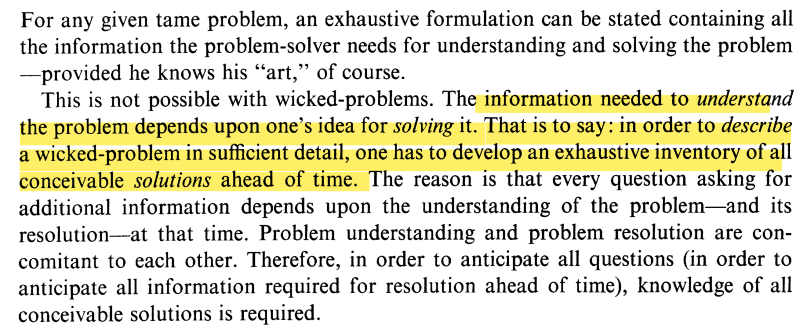The theory of ‘wicked problems’ originated in the planning literature in 1973. Horst Rittel and Melvin Webber proposed that planning could no longer be efficiently managed by scientists and engineers due to the trickiness of goal setting and problem definition in dynamic systems with feedback loops, and the commensurate requirement to proceed fairly and equitably in the public interest.

The open ended nature of wicked problems ensure that the dilemmas to be explored are unique. As Rittel and Webber theorised, there could be no independent verification of correctness and solutions could not be uniquely documented. System effects were persistent, and an endless causal chain could often identify each wicked problem as a symptom of another problem yet to be revealed.
Wicked problems and public policy issues are endlessly changing and interconnected – they are complex not merely linear and technical – and interconnected with greater, and (themselves) forever dynamic, social, biological, political and economic factors.
Rittel and Weber envisaged these problems as containing distinct features, they could be malignant (rather than benign), vicious (such as a vicious cycle), tricky (difficult to calculate) and/or aggressive (fierce rather than docile) (Rittel & Webber, 1973, p. 160). The properties observed as particular to wicked problems properties that are evident in the great challenges of our age.
Rittel and Webber’s insight was that the potential to deal with a wicked problem was dependent upon how far upstream enquiry could go, theorising that:

Wicked problems are by nature, a messy, imperfect process.:
‘the higher the level of a problem’s formulation, the broader and more general it becomes: and the more difficult it becomes to do something about it’, rather the aim would be to try ‘to settle the problem on as high a level as possible’ Rittel & Webber, 1973, p. 165).
The Political Problem
Interactions of human activity and biological systems are not merely complicated, rather, they are dynamic and complex. This shifts uncertainty, which can be dually ontological, epistemological and ethical, into a central place in deliberation. Funtowicz and Ravetz suggested that the science required to navigate these environments was ‘post-normal’ (Funtowicz & Ravetz, 1995). The structural and biological wicked problems of modernity, as identified by Will Steffan and colleagues (Steffen, et al., 2015), by scholars research non-communicable disease (The Lancet, 2019; Swinburn, et al., 2019) and endocrine disruption (Attina, et al., 2016; Demeneix & Slama, 2019) require not merely complicated puzzles. Instead these involve intersectional biological and social challenges where ‘uncertainties are either of the epistemological or the ethical kind, or when decision stakes reflect conflicting purposes among stakeholders’ (Funtowicz & Ravetz, 1995, p. 155).
Wicked problems are the effect of interplay betweensocial, biological, political and economic factors and they often involve degradation or harm, of human and environmental health. produced stressors and the vulnerability of biological tipping points, and extend beyond town planning. The complexities that underpin the risk of overshoot of the planetary boundaries identified by Will Steffan and colleagues (Steffen, et al., 2015); the growth of new technology that lacks adequate monitoring and regulatory oversight to ensure human and environmental health are protected (Persson, et al., 2021); and the creep of diet-associated non-communicable disease from the first world into the developed world, as global citizens shift away from ancestral diets and activities to modern environments and dietary exposures (The Lancet, 2019).
There could be no singular root cause, thus the work would be always to ‘re-solve’ issues. This places wicked problem management on an ontological and ethics or values-based platform and a matter of ‘judgement’. How can decision-makers know all the correlating factors that create the wicked problem, and the degree to which the wicked problem creates chaos? They can’t. The question instead, steps into an indeterminate ethical space; – how far upstream should society go to address wicked problems. For Rittel and Webber, the liminal space contained a singular goal ‘improve some characteristics of the world where people live’ (Rittel & Webber, 1973, p. 167). This understanding placed knowledge production and judgement, guided by values that would prioritise the public good, at the heart of modern decision-making, while emphasising that uncertainty would be a constant feature of such endeavour (Bradford Hill, 1965/2015; Funtowicz & Ravetz, 1995). Unfortunately for decision-makers, there could be no fixed suite of policy measures to address wicked problems, and measures would always contain within them the potential to create more wicked problems.
Due to the potential for harm to be attributed and this to be associated with political and economic activity, controversy often plagues wicked problems, and judgement of public benefit uncertain and ambiguous, with high levels of contestation between interest groups a likely outcome (Parkhurst, 2016). Wicked problems and solutions carry with them a long tail of risk and consequence that is impossible to accurately verify and value, and while every action left a trace or effect, the dilemma arose that every action counted (but could not be counted).
Which knowledge to pursue requires uncertain ‘judgement’, implying a considered process involving choice, or discretion, where ‘the modes of reasoning used in the argument are much richer than those permissible in the scientific discourse’ (Rittel & Webber, 1973, p. 166).
This echoes Sheila Jasanoff’s emphasis on the significance of virtuous reasoning, as a way of ensuring the practice of science conforms to wider social values and is best able to advance desired public ends, rather than narrow interest groups (Jasanoff, 2011).
Values that inform judgement
1. What values are applied within the modes of reasoning to enable that judgement – what is to be prioritised and valued.
2. What resources are dedicated to dealing with the wicked problem. This is also a function of values – how do political and social actors value tackling a wicked problem and thereby dedicate resources?
3. How long is granted to solving the wicked problem and is the long-term nature of the problem built into policy? Decisions relating to the temporal window – are a function of values which enable an issue to be solved.
4. The degree of autonomy granted to decision-making actors which enable them to navigate uncertain interconnected issues. If decision-making is prescribed from higher levels of management, actors will find it difficult to work in uncertainty; and prioritise new and relevant issues.
5. The degree to which uncertainty is permitted in decision-making and the buffering of decision-makers from private commercial interests.
6. The degree to which uncomfortable knowledge is permitted to be discovered, and scrutiny permitted.
Of course, wicked problems, by definition, are the bête noire of the policy planner, the town planner, and the media that forever seeks a tidy ending.
Bibliography
Attina, T., Hauser, R., Sathyanarayana, S., Hunt, P., Bourguignon, J., Myers, J., . . . Trasande, L. (2016). Exposure to endocrine-disrupting chemicals in the USA: a population-based disease burden and cost analysis. Lancet Diabetes Endocrinol 2016; 4: 996–1003. Lancet Diabetes and Endocrinology, 4(12), 996-1003. Retrieved from https://www.thelancet.com/journals/landia/article/PIIS2213-8587(16)30275-3/fulltext
Bradford Hill, A. (1965/2015). The environment and disease: association or causation? The Royal Society of Medicine, 108(1), 32-37.
Demeneix, B., & Slama, R. (2019). Endocrine Disruptors: from Scientific Evidence to Human Health Protection. requested by the European Parliament’s Committee on Petitions. PE 608.866 – March 2019. Brussels: Policy Department for Citizens’ Rights and Constitutional Affairs.
Funtowicz, S., & Ravetz, J. (1995). Science for the Post Normal Age. In L. Westra, & J. Lemons, Perspectives on Ecological Integrity. Vol.5 (pp. 146-161). Springer-Science+Business Media, B.V. .
Jasanoff, S. (2011). Quality control and peer review in advisory science. In J. Lentsch, & P. Weingart (Eds.), The politics of scientific advice: Institutional design for quality assurance (pp. 19–35). Cambridge:: Cambridge University Press.
Parkhurst, J. (2016). Appeals to evidence for the resolution of wicked problems: the origins and mechanisms of evidentiary bias. Policy Sci, 49, 373-393.
Rittel, H., & Webber, M. (1973). Dilemmas in a general theory of planning. Policy Sciences, 4(2), 155-69.
Steffen, W., Richardson, K., Rockstrom, J., Cornell, S. E., Fetzer, I., Bennett, E. M., . . . Persson, L. M. (2015). Planetary boundaries: Guiding human development on a changing planet. Science.
Swinburn, B. A., Kraak, V. I., Allender, S., Atkins, V., Baker, P., Bogard, J., . . . Friel, S. (2019). The Global Syndemic of Obesity, Undernutrition, and Climate Change: The Lancet Commission report. The Lancet, 791-846.
The Lancet. (2019). Global Burden of Disease. Retrieved from The Lancet: https://www.download.thelancet.com/gbd